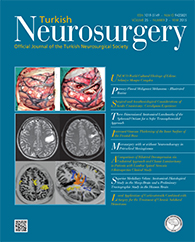MATERIAL and METHODS: The morphological features of the SO were studied in 352 skull base by 3D-Doctor Demo version.
RESULTS: The mean diameters of the SO were measured as 5.8 ± 1.3 mm (right) and 5.9 ± 1.2 mm (left), respectively. The mean distance from the SO to the midline was measured as 2.3 ± 1.1 mm (right) and 1.8 ± 0.9 mm (left), respectively. 8 bones had SO on one side, whilst 4 bones had no SO. In 5 bones there was a double SO structure on one side. 74.4% of ovoid SO specimens have the largest perimeter, therefore, allow the highest degree of surgical success. It was noted that they were not symmetrical (21.8%). Openings were found to be at different distances from the midline, some at different distances from the floor; in addition, differently shaped openings, as well as those with an opening absent on one side or with double openings, were observed.
CONCLUSION: Separate coordinates and safe routes must be calculated for right and left openings. The SO analysis could eliminate some of standardization measurements of an exposed surgical area.
Keywords : Sphenoid ostium, Sphenoid sinus, Transsphenoidal approach




